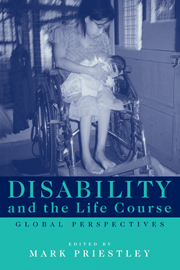Book contents
- Frontmatter
- Contents
- List of figures
- List of tables
- Notes on contributors
- Preface
- Acknowledgements
- A brief note on terminology
- I Concepts
- II Methods and stories
- 6 Life event histories and the US independent living movement
- 7 A journey of discovery
- 8 Using life story narratives to understand disability and identity in South Africa
- 9 Social change and self-empowerment: stories of disabled people in Russia
- 10 Lifting the Iron Curtain
- 11 Revisiting deaf transitions
- 12 The hidden injuries of ‘a slight limp’
- III The politics of transition
- Index
8 - Using life story narratives to understand disability and identity in South Africa
Published online by Cambridge University Press: 30 September 2009
- Frontmatter
- Contents
- List of figures
- List of tables
- Notes on contributors
- Preface
- Acknowledgements
- A brief note on terminology
- I Concepts
- II Methods and stories
- 6 Life event histories and the US independent living movement
- 7 A journey of discovery
- 8 Using life story narratives to understand disability and identity in South Africa
- 9 Social change and self-empowerment: stories of disabled people in Russia
- 10 Lifting the Iron Curtain
- 11 Revisiting deaf transitions
- 12 The hidden injuries of ‘a slight limp’
- III The politics of transition
- Index
Summary
There is a rapidly growing body of research focusing on how people use language to construct personal meaning and identity (de Certeau 1984, Miller et al. 1990, Rosaldo 1993). Accordingly, scholars have renewed their interest in life story narratives as a way to access the construction of self (Gee 1991, Linde 1993, Sun 1998). Life stories are a type of narrative, providing a window through which we can examine the ways that individuals actively interpret and negotiate their reality. In the process of telling their life stories, people construct meaning by selecting, evaluating and emphasising significant experiences (Linde 1993). Thus life stories are important sites of social-cultural identity construction, in which people make sense of their relation to themselves and to others.
Life stories as a research tool in disability studies
The analysis of life story narratives is an exciting qualitative research methodology, yielding rich and textured data on the lives of disabled individuals, in the context of the broader society. Although life stories have been used increasingly by social scientists to document the lives of marginalised groups (Lincoln 1993), they have not been used a great deal in research focusing on disabled people. Disability research frequently privileges the voices of able-bodied outsiders and excludes those of disabled people. Considering that research is often conducted by outsiders, life story narratives provide an opportunity for collaboration that privileges the voices of insiders.
- Type
- Chapter
- Information
- Disability and the Life CourseGlobal Perspectives, pp. 89 - 100Publisher: Cambridge University PressPrint publication year: 2001
- 4
- Cited by



